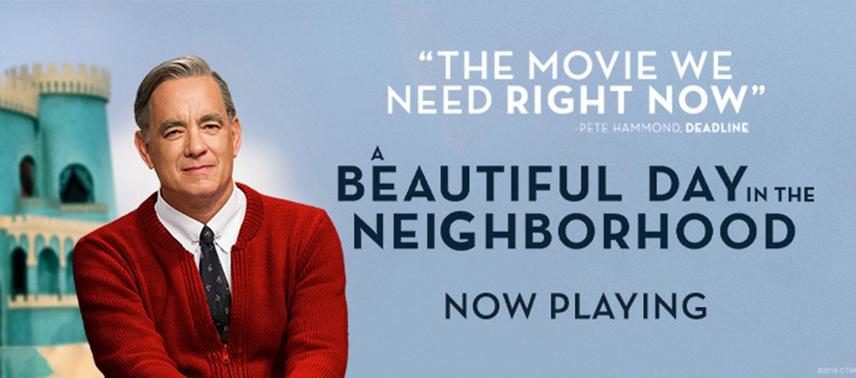How should we deal with anger? Why do we hold onto it instead of attempting forgiveness, hard as forgiveness may be? How can we begin to constructively deal with feelings holding us back? “A Beautiful Day in the Neighborhood” attempts to answer these questions by way of Mr. Rogers’ story.
“Beautiful Day” is inspired by the true story of how Fred Rogers (Tom Hanks) helped cynical journalist, Lloyd Vogel (Matthew Rhys) learn to deal with his feelings and build a better life for himself. It is a film full of hope, healing and lessons for a world in pain. The events are set in 1998, but its story feels more important now than ever. It offers essential opportunities for a conversation on constructive ways to deal with toxic emotions that can cause hurt, not just to yourself but to others as well.
“Mr. Rogers’ Neighborhood” was a public television show conceived by host Rogers; it ran for 31 seasons from 1968-2001. It dealt with difficult topics from war to divorce to death, all with a warmth that made both children and adults feel at ease. It taught children that their feelings were valid and could be dealt with in a healthy way.
The film itself mimics the format of an episode of “Mr. Rogers’ Neighborhood,” incorporating the same starting and ending sequences as the show. It isn’t so much about Mr. Rogers as it is about how his message of kindness shaped someone’s life. Just like the show, the film also features functional dioramas which are stunning, nostalgic and help bring in a little bit of the “Neighborhood” to the reality of the film. They are used to show traveling sequences similar to how the mini diorama trolley would travel to the land of make-believe on the show. It helps to connect the reality of the film to the elements of imagination that accompany Mr. Rogers’ aura.
Director Marielle Heller once again proves her power to emotionally connect with an audience and allow understated moments to say big things. Her previous film “Can You Ever Forgive Me?” did an excellent job of finding moments where there is a common thread between the viewer’s life and the moment. This film is no different. Heller is not afraid to let the movie stray from the typical biopic formula and gives actors time to work the silences. The weight in the simple words, such as a question Rogers asks Lloyd about a childhood toy, shows her precise, emotion-driven directing and gives these scenes much more power than if they were in the stylings of another director.
All that being said, it never feels like the film is pandering to its audience and trying to pound a specific message into them. It offers its messages up with subtle care and consideration. Just like Mr. Rogers, the film doesn’t talk at the audience; it allows the viewer to feel seen and take whatever they need from the story.
Instead of imitating Mr. Rogers, Hanks chooses to emulate him. Instead of putting on a potentially contrived accent, Hanks puts Mr. Rogers’s heart and soul on display. Though the actor’s icon status makes it initially hard to look at the character and not just see Hanks, he ultimately does a great job of making the audience suspend their disbelief for two hours. Hanks is a Mr. Rogers who is not so much a pious, inaccessible hero as a humble man whose desire is to make each person he meets feel special and heard.
Rhys gives an equally moving performance as Esquire journalist Vogel, based on journalist Tom Junod. His character could have easily been played as cynical through and through, but even in moments of dark emotion, Rhys hints at the underlying fear and need for understanding that Rogers eventually shines a light on. His ability to turn an easy-to-despise role into a character the audience is sure to want to root for and see change for the better is a testament to his talent.
“Beautiful Day” shines in its moments of silence. There is an astonishing amount of complete silence in the film, but these moments never feel tedious or awkward; they feel full of life and help to push the story forward. One of the finest examples is from a conversation Vogel and Rogers have in the latter’s New York apartment. Just from slight glances and facial movements, a scene builds and the silence is suddenly filled with a conversation. These silent moments also allow the audience to see the characters in one of their most telling states — reflection, wondering how to respond to whatever has just occurred.
At a time of such turmoil and anger in the world, it is good to take a minute to reflect on those who have, as Mr. Rogers said, “loved us into being.” After this film, it will be hard not to run off to call all the special people in your life to tell them how much you love and appreciate them. “Beautiful Day” is a healing experience and offers a chance to remember the greatest neighbor we were ever lucky enough to have.
A version of this article appears in the Monday, Nov. 25, 2019, print edition. Email Kaylee DeFreitas at [email protected].
























































































































































